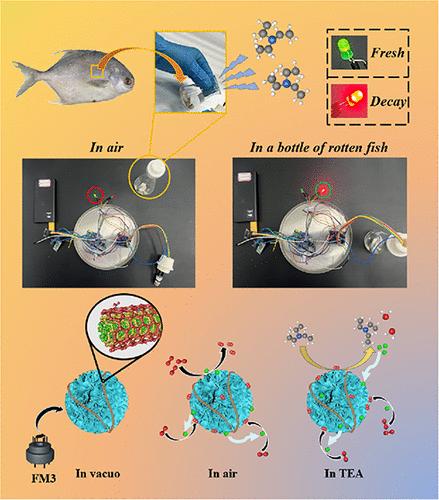Flower-like FeWO4/f-MWCNTs Sphere for Triethylamine Gas Sensors Operating at Room Temperature: Sensing Performance, Mechanism Study, and Application to Detection of Fish Freshness
IF 9.1
1区 化学
Q1 CHEMISTRY, ANALYTICAL
引用次数: 0
Abstract
Triethylamine (TEA) is a colorless organic liquid known for its high volatility that poses significant irritation to the human respiratory tract; meanwhile, TEA can be released from decaying fish, which can be monitored by a gas sensor. However, conventional TEA gas sensors typically require high operating temperatures, leading to a substantial energy consumption. To address food safety concerns and promote environmental sustainability, the advancement of a TEA sensor that works at room temperature is urgently needed. In our work, an FeWO4/f-MWCNTs-3 chemoresistive gas sensor was fabricated by the hydrothermal method, integrating FeWO4 with multiwalled carbon nanotubes treated with mixed acids (f-MWCNTs). The sensor demonstrates superior performance, owing to its elevated specific surface area, total pore volume, and synergistic effect of p–p heterojunctions. FeWO4/f-MWCNTs-3 demonstrates excellent reproducibility, moisture resistance, stability, a minimal detection threshold of 1 ppm, and relatively rapid response/recovery times of 15/63 s. It attains a 113% response at 100 ppm of TEA at 25 °C. The applicability of FeWO4/f-MWCNTs-3 for assessing fish freshness via TEA concentration analysis from pomfret fish stored at ambient temperature for 14 days was validated, indicating its significance in fish freshness detection methodologies. Additionally, the gas-sensing mechanism of this sensor was further explored using density functional theory (DFT).

室温下用于三乙胺气体传感器的花状FeWO4/f-MWCNTs球体:传感性能、机理研究及其在检测鱼类新鲜度中的应用
三乙胺(TEA)是一种无色有机液体,以其高挥发性而闻名,对人体呼吸道造成严重刺激;同时,TEA可以从腐烂的鱼中释放出来,这可以通过一个气体传感器来监测。然而,传统的TEA气体传感器通常需要较高的工作温度,从而导致大量的能源消耗。为了解决食品安全问题和促进环境可持续性,迫切需要在室温下工作的TEA传感器的进步。在我们的工作中,通过水热法将FeWO4与混合酸处理的多壁碳纳米管(f-MWCNTs)集成在一起,制备了FeWO4/f-MWCNTs-3化学阻性气体传感器。该传感器由于具有较高的比表面积、总孔隙体积和p-p异质结的协同效应而表现出优异的性能。FeWO4/f-MWCNTs-3具有优异的重现性、耐湿性、稳定性、最小检测阈值为1 ppm,相对快速的响应/恢复时间为15/63 s。在25°C下,当TEA浓度为100 ppm时,其响应率为113%。验证了FeWO4/f-MWCNTs-3通过分析环境温度下储存14天的鲳鱼的TEA浓度来评估鱼类新鲜度的适用性,表明其在鱼类新鲜度检测方法中的重要性。此外,利用密度泛函理论(DFT)进一步探讨了该传感器的气敏机理。
本文章由计算机程序翻译,如有差异,请以英文原文为准。
求助全文
约1分钟内获得全文
求助全文
来源期刊

ACS Sensors
Chemical Engineering-Bioengineering
CiteScore
14.50
自引率
3.40%
发文量
372
期刊介绍:
ACS Sensors is a peer-reviewed research journal that focuses on the dissemination of new and original knowledge in the field of sensor science, particularly those that selectively sense chemical or biological species or processes. The journal covers a broad range of topics, including but not limited to biosensors, chemical sensors, gas sensors, intracellular sensors, single molecule sensors, cell chips, and microfluidic devices. It aims to publish articles that address conceptual advances in sensing technology applicable to various types of analytes or application papers that report on the use of existing sensing concepts in new ways or for new analytes.
 求助内容:
求助内容: 应助结果提醒方式:
应助结果提醒方式:


